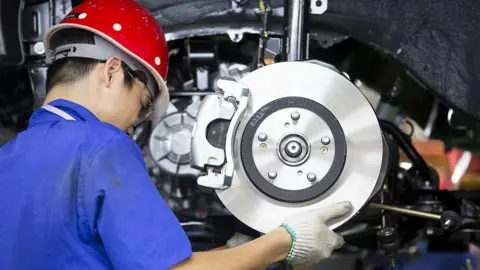Garage owner Kevan Gibbons has noticed many changes in his 45 years in the motor trade.
Cars are much bigger than when he started out. Driving styles have changed too, with more frequent stopping.
All that starting and stopping, which tends to happen more when driving in urban areas, wears down brakes faster.
So do heavier vehicles and higher temperatures.
Brake pad quality and prices have also lowered over time, in Mr Gibbons’ experience.
This is significant because “the poorer the quality, the more dust you get”, he explains.
While tailpipe emissions have dramatically reduced, other cars parts are producing a greater share of the pollution.
In many major cities, brake wear is now the biggest source of non-exhaust emissions from vehicles, according to EIT Urban Mobility – an EU-supported organisation focused on improving urban transport.
Yet “there seems to be limited awareness of this pollution,” says its director of innovation, Adriana Diaz.
Brake dust contains tiny bits of metal, black carbon and other particles that enter the air due to friction and the wearing away of braking materials.
There are even some studies which suggest brake dust is even more harmful to the lungs than diesel exhaust.
Electric vehicles produce no exhaust emissions and have much less brake wear. Regenerative braking in EVs, which recharges the battery, does not involve friction. However, even EVs with regenerative braking also incorporate some friction braking.
Now the auto industry is poised to properly tackle brake emissions for the first time as the European Union introduces the world’s first rules limiting the level of brake emissions next year.
Under the new Euro 7 regulations, brake emissions of PM10 (particles of less than 10 micrometres in diameter) from new vehicles will be limited to 3–11 mg/km, depending on the vehicle type.

At the moment, a typical car with a grey cast iron brake disc and low-steel brake pads – a common combination in Europe – emits about 8.8 mg/kg of PM10, according to EIT Urban Mobility.
The EU predicts that by 2035, the regulations will reduce the particles emitted from the brakes of cars and vans by 27%.
Other regions are likely to follow suit. “China will be the next,” says Artur García, an aftermarket braking engineering manager for the auto parts maker DRiV (part of Tenneco).
He’s expecting so-called China 7 regulations to be announced by the end of 2025, and to focus more on PM2.5 (particles even tinier than PM10).
Euro 7 is starting with brake emissions before moving onto other types of non-exhaust emissions.
It’s simpler to measure brake emissions than other types of non-exhaust emissions “because you can isolate the braking system in labs”, explains François Cuenot, the secretary of the Working Party on Pollution and Energy, a UN organisation that sets standards for measuring vehicle emissions.
Compared to brakes, it’s much more difficult to separate out the emissions from tyres and roads, which interact with each other in complex ways.
There are two main ways that manufacturers will reduce brake emissions, Mr Cuenot says.
The cheapest method involves applying a coating that strengthens brake discs and thus reduces wear. Manufacturers can also change the composition of the brake pads to lower-wear materials.
Different regions have embraced different brake pad components, with a focus on either performance or comfort. Africa, Europe, Latin America and South Asia tend to use low-steel brake pads, which are more responsive to the driver.
Non-asbestos organic brake pads are used more in North America and East Asia. They allow smoother driving over long distances, as well as significant reductions in PM10.
There are also concerns about the toxicity of brake pad components, which can affect water quality and human health. The EU bans asbestos in brake pads, while California goes further in also restricting copper.
Euro 7 does not further limit materials in brake pads. In general, EIT Urban Mobility is concerned that low-wear brake systems might use more toxic materials.

But some manufacturers have decided to go further than the regulations. The Greentell brake set of Italian brake manufacturer Brembo does not contain copper, cobalt or nickel.
Greentell relies on a technique called laser metal deposition, which uses a high-powered laser beam to melt a material (such as a powdered metal) and layer it onto a surface.
Fabiano Carminati, Brembo’s head of brake-disc development, says that the company chose laser metal deposition for this premium brake product because it produces the best results in terms of both emissions reduction and driving enjoyment.
Brembo reports that with Greentell, PM10 emissions are reduced by around 60 to 90% in lab-based testing, depending on the vehicle and its original braking system.
The auto parts maker Tenneco also offers copper-free, lower-emissions brake products. According to the company, its Fuse+ brake pads, which use a new friction material, reduced PM10 emissions by 60% in internal tests.
They also help reduce noise – an aspect that drivers of electric vehicles tend to notice more, such as squeaky brakes.

As for other materials, EIT Urban Mobility estimates that replacing grey cast iron discs with carbon-ceramic composite discs reduces PM10 by 81%.
Particle filters can also be fitted to collect the brake dust. But regularly maintaining the filter may be a burden for the vehicle owner, Mr Cuenot says. And “if you don’t maintain the filter, then the emissions will go in the atmosphere.”
Drum brakes might also see a resurgence because of Euro 7. In drum brakes, friction is generated by brake shoes pressing against the interior of a rotating drum. Because “they keep everything inside the drum,” as Mr Cuenot says, the particles are also contained.
Tenneco has noticed that though drum brake demand in the automotive aftermarket was previously declining rapidly, this has slowed.
According to EIT Urban Mobility, drum brakes produce around 23% less wear than disc brakes, which involve a rotating disc and brake pads. However, drum brakes have typically been less durable than disc brakes, particularly in high heat.
With less-emitting brake systems, drivers might eventually notice less brake dust accumulating on the rims of their wheels, according to Mr Cuenot.
Car makers, meanwhile, may notice more expensive brake parts. Companies will have to contend with the added costs of not just research and development and different materials, but also potentially new testing systems to comply with regulations.
Luxury and premium vehicles may already be fitted out with low-emissions brake systems, which are costlier. The EU regulations will lead to these being extended to more affordable cars as well.
But the picture will be different in places without limits on non-exhaust emissions, like the UK.
In Mr Gibbons’ experience, working in Manchester in the north of England, nine out of 10 customers don’t care about the health or environmental effects of things like brake dust.
Given the high cost of living, “it just comes down to one word, and that’s money.”
On the plus side, lowering brake emissions should improve air quality. But mobility experts emphasise that this is only a very limited solution to the health and environmental effects of cars, including electric ones.
“I think it’s good that there is a specific and concrete call for action,” Ms Diaz says. “It’s absolutely necessary.” But she stresses that bigger wins will come from reorganising cities and shifting transport modes so that there’s less driving overall.
This is more challenging politically than imposing a brake emissions limit, but Ms Diaz remains optimistic after seeing Barcelona residents increasingly enjoying and accepting low-traffic superblocks.













